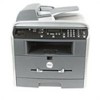Dell 1600n Multifunction Mono Laser Printer Dell Laser Multi-Function Printer - Page 173
Paper Output Capacity, Printer and Paper Storage Environment, Category, Specifications
 |
View all Dell 1600n Multifunction Mono Laser Printer manuals
Add to My Manuals
Save this manual to your list of manuals |
Page 173 highlights
Category Specifications Acid Content 5.5 pH or lower Caliper 0.094-0.18 mm (3.0-7.0 mils) Curl in Ream Flat within 0.02 in. (5 mm) Cut Edge Conditions Cut with sharp blades with no visible fray. Fusing Compatibility Must not scorch, melt, offset or release hazardous emissions when heated to 200°C (392°F) for 0.1 second. Grain Long Grain Moisture Content 4%-6% by weight Smoothness 100-400 Sheffield Paper Output Capacity Output Location Capacity Front Output Tray (Face Down) 150 sheets of 75 g/m2 bond (20 lb) paper Rear Output Slot (Face Up) 1 sheet of 75 g/m2 bond (20 lb) paper Printer and Paper Storage Environment Paper storage environmental conditions directly affect the feed operation. Ideally, the printer and paper storage environment should be at or near room temperature, and not too dry or humid. Remember that paper is hygroscopic; it absorbs and loses moisture rapidly. Heat works with humidity to damage paper. Heat causes the moisture in paper to evaporate, while cold causes it to condense on the sheets. Heating systems and air conditioners remove most of the humidity from a room. As paper is opened and used, it loses moisture, causing streaks and smudging. Humid weather or water coolers can cause the humidity to increase in a room. As paper is opened and used it absorbs any excess moisture, causing light print and dropouts. Also, as paper loses and gains moisture it can become distorted. This can cause paper jams. Care should be taken not to purchase more paper than can be used in a short time (about 3 months). Paper stored for long periods may experience heat and moisture extremes, which can cause damage. Planning is important to prevent damage to large supplies of paper. Unopened paper in sealed reams can remain stable for several months before use. Opened packages of paper have more potential for environment damage, especially if they are not wrapped with a moisture-proof barrier.















